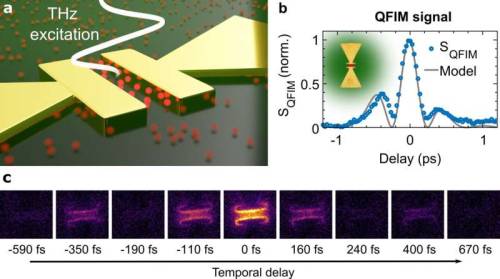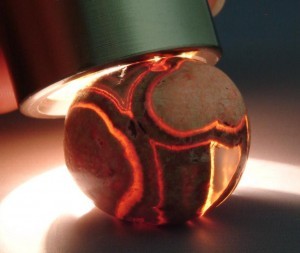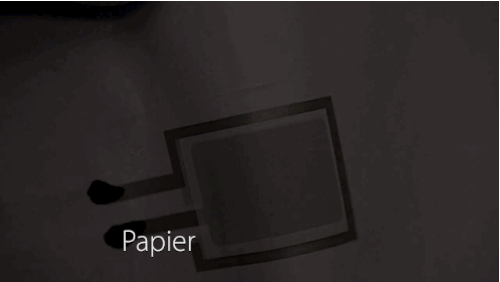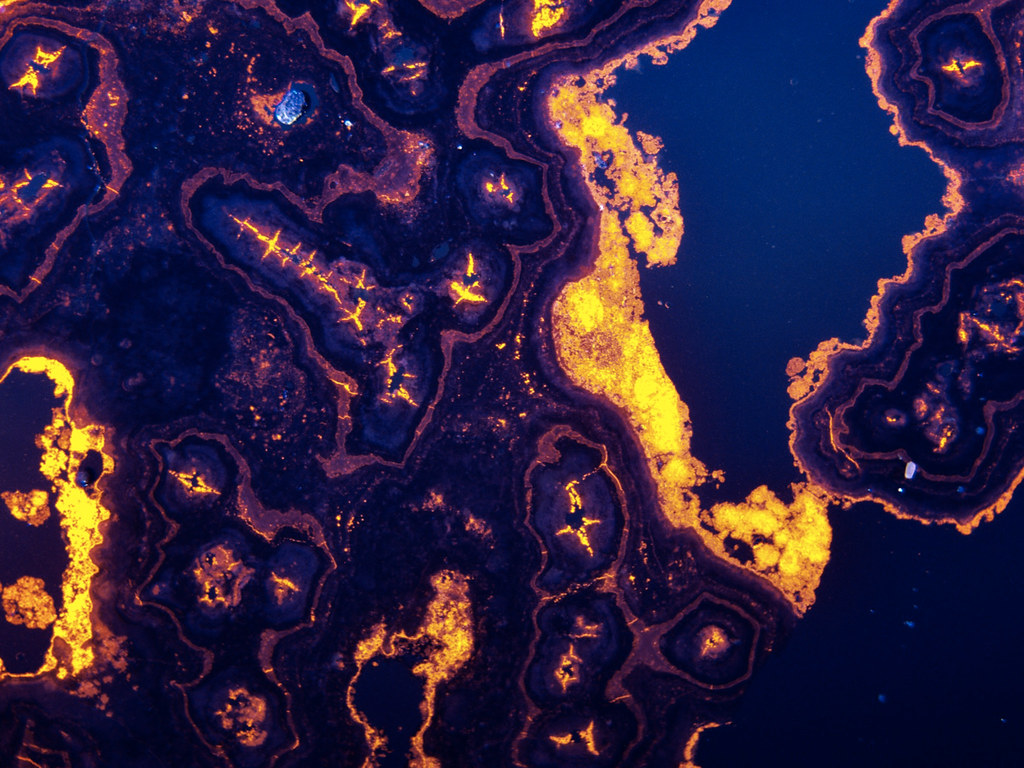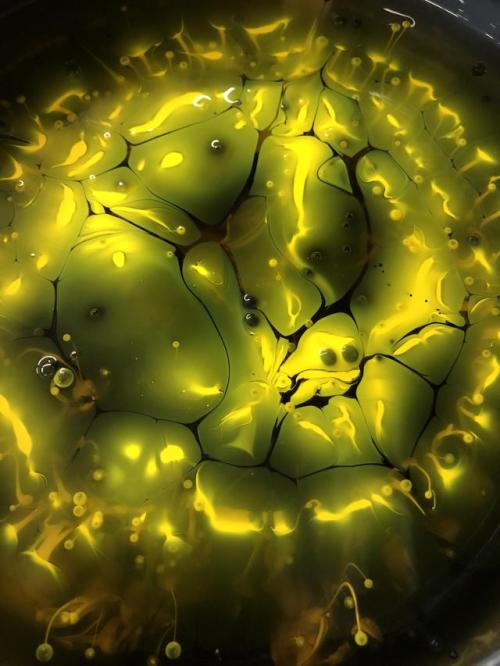#luminescence
Ultrafast imaging of terahertz electric waveforms using quantum dots
Microscopic electric fields govern a remarkable variety of phenomena in condensed matter and their ultrafast evolutions drive plasmonics, phononics and highspeed nanoelectronics. Access to high-frequency electric waveforms is of crucial importance to diverse disciplines in nanoscience and technology, yet, microscopic measurements are still severely limited.
In a new paper published in Light: Science & Applications, a team of scientists, led by Prof. Georg Herink from the University of Bayreuth, Germany, and co-workers from the University of Melbourne, Australia, has introduced a new THz microscope for imaging ultrafast electric waveforms encoded in the visible luminescence of nanocrystal probes. Strong electric fields modulate the emission yield of nanocrystals and enable the detection of THz near-field waveforms by microscopy of visible photons in the far-field.
The researchers generated ultrafast electric fields inside gold structures using intense Terahertz pulses. A layer of semiconductor nanocrystals covering the samples is excited by ultrashort visible pulses and shows modulated visible emission depending on the momentary local THz electric field. Fundamentally, this probing of electric fields via luminescence yield is enabled by the quantum-confined Stark effect in quantum dots, generating the contrast mechanism of the scheme termed Quantum-Probe Field Microscopy (QFIM). While scanning the temporal delay between THz excitation and optical pulses, an optical fluorescence microscope captures snapshots of the modulated local emission and generates movies of the local fieldevolution.
Post link
Nanorosesby Argonne National Laboratory
NanorosesBy Vilas G. Pol These tiny crystalline “roses” of europium oxycarbonate are formed under intense heat and pressure in a controlled system. Under certain conditions, they emit bright red light. Scientists are working to investigate the material’s luminescence intensity and decay time. Europium oxide, a related compound, has proven useful in lasers and high-density optical storage devices, and researchers hope to discover more about this unusual oxycarbonate compound and its potential applications. Previously published: Pol V.G. et al. Inorg. Chem. 2009, 48, 5569–5573
Post link
Though you may not have heard of them, electroluminescent lamps are everywhere. EdisonTechCenter on YouTube describes how an EL Lamp works, how they are made, what they are made of, and where we see these kind of lamps in everyday life, as well as the history of electroluminescence.
Types of Luminescence
Despite the numberof typesof luminescencealready covered, there are still several more to talk about.
Electroluminescence is when light is emitted due to the passage of an electric current or a strong electric field and is usually seen in semiconductors (such as LEDs). Electroluminescent technologies use relatively low power, though at high voltage, and can be quite thin. This form of luminescence is responsible for the two central images shown above, as well as the Indiglo feature available in many watches.
Similar to electroluminescence, cathodoluminescence is a form of luminescence in which electrons impact a luminescent material and cause the emission of photons which may have wavelengths in the visible spectrum and is mainly seen in semiconductors. One well known example is in cathode ray tubes in televisions. Optical cathodoluminescence microscopes can be used similarly to scanning electron microscopes to examine internal structures of materials.
Radioluminescence occurs by bombardment of materials with ionizing radiation such as beta particles. It is used in applications where light must be produced for long periods without external energy sources. The upper left hand images are illuminated using radioluminescence.
Thermoluminescence is a form of luminescence that is exhibited by certain crystalline materials when previously absorbed energy is re-emitted as light upon heating of the material. It is not the same as black body radiation, when a material glows due to heating. It’s main application is in dating buried objects that have been heated in the past, such as pottery. The upper right image and bottom image illustrate thermoluminescence.
Finally, crystalloluminescence is luminescence produced during crystallization, but it has not been widely studied and not much is known about it.
Sources:Electroluminescence,Cathodoluminescence,Radioluminescence,Thermoluminescence,Crystalloluminescence
Post link
The above video, from YouTuber Julien Simon shows the thermoluminescent properties of fluorite crystals.
Precisely tailoring the dynamics of upconversion luminescence
A team of researchers led by Professors Hong Zhang (photonic nanochemistry) and Evert Jan Meijer (computational chemistry) of the University of Amsterdam’s Van ’t Hoff Institute for Molecular Sciences has significantly improved the fundamental understanding of photon upconversion in nanoparticles. Through the collaborative approach of advanced spectroscopy and theoretical modelling they were able to establish that the migration of excitation energy greatly affects the upconversion dynamics. In a recent publication in Angewandte Chemie the researchers describe how ‘dopant ions spatially separated’ (DISS) nanostructures can be used for tailoring the upconversion dynamics.
Upconversion is a process in which one photon is emitted upon absorption of several photons of lower energy. It thus 'jacks’ the light from lower to higher frequencies. Typically upconversion materials are doped with lanthanide ions. These are able to shift the near infrared (NIR) light of an economic continuous wave milliwatt laser towards higher, visible frequencies and even into the ultraviolet (UV) spectral region. Potential applications in super resolution spectroscopy, high density data storage, anti-counterfeiting and biological imaging and photo-induced therapy.
Upconversion luminescence dynamics has long been believed to be determined solely by the emitting ions and their interactions with neighbouring sensitizing ions. The current research shows that this does not hold for nanostructures. Zhang, Meijer and co-workers demonstrate that in nanocrystals the luminescence time behaviour is seriously affected by the migration process of the excitation energy.
Post link
Molecular switch detects metals in the environment
Researchers from UNIGE have developed a new type of chemical sensor capable of detecting the presence of metals in the environment
An international team, led by researchers from the University of Geneva (UNIGE), Switzerland, has designed a family of molecules capable of binding to metal ions present in its environment and providing an easily detectable light signal during binding. This new type of sensor forms a 3D structure whose molecules are chiral, that is to say structurally identical but not superimposable, like an image and its reflection in a mirror, or like the left and right hands. These molecules consist of a ring and two luminescent arms that emit a particular type of light in a process called Circular Polarized Luminescence (CPL), and selectively detect ions, such as sodium. This research can be read about in Chemical Science.
“The luminescent arms of our molecules function like light bulbs that light up or turn off depending on the presence of a positively charged ion, a metal cation,” explains Jérôme Lacour, Dean of the Faculty of Science at UNIGE and Ordinary Professor in the Department of Organic Chemistry. These molecules can be compared to small locks: when they are ready to operate and detect the presence of metals, they emit a particular type of light (circularly polarized). When a metal ion is inserted, it acts on them like a key, the lock geometry changes and the light disappears.
Post link
Glowing Paper & Clear Film Bring Flexible Electronics Closer
Light-emitting paper and film have been created in China and Germany, signalling another advance of flexible electronics that will one day be worn on the sleeve or folded up and stuffed in a pocket.
At the Karlsruhe Institute of Technology, engineers have improved on the process of making a material called electroluminescent foil, which glows when current flows through it. They say they can now directly print electroluminescent layers onto other materials like paper and plastic. Their pad-printing process can even be used to layer the film onto convex, concave or other three-dimensional surfaces.
“Any type of three-dimensional object can be provided with electroluminescent coatings at low costs,” said Rainer Kling, a senior scientist at KIT’s Light Technology Institute.
Post link
Developing inorganic lead-free perovskite for broadband emission
Artificial lighting accounts for one-fifth of global electricity consumption, and developing efficient and stable luminescence materials is critical to avoid unnecessary waste of electric energy. The single emitters with broadband emission, such as lead halide perovskites, have recently triggered tremendous attention for artificial illumination and display applications. To develop lead-free and stable perovskites with broadband emission, researchers in China targeted low-dimensional bismuth halide perovskites.
They published their work on Apr. 15 in Energy Material Advances.
“The single emitters with broadband emission can circumvent critical problems faced in the traditional mixed and multicomponent emitters such as the efficiency losses caused by self-absorption, the complex device structure, and the colors instability due to the different degradation rates of phosphors,” said paper author Rengui Li, a professor with the State Key Laboratory of Catalysis, Dalian National Laboratory for Clean Energy, Dalian Institute of Chemical Physics, Chinese Academy of Sciences (CAS). “Lead halide perovskites have emerged as highly attractive next-generation optoelectronic materials for light-emitting applications due to their extraordinary photoelectric properties.”
Post link
Time‑correlated single‑photon counting technique to visualize weak pulse electroluminescence
Time‑correlated single‑photon counting (TCSPC) technique is a powerful way to measure the weak light signals. The basic principle behind TCSPC is the photoelectric effect in which an electrical charge is released by absorbing a photon. Compared to the traditional strategy of detecting analog photogenerated voltage, the TCSPC technique counts the single electron pulse created by single photons, which means its sensitivity can be up to single-photon level as its name implies. In fact, the TCSPC technique has been successfully employed to detect the transient/burst photoluminescence (PL) in many research fields, and the transient spectrometer is common equipment in many labs.
Dr. Xianfeng Qiao and Prof. Dongge Ma at South China University of Technology (SCUT), China, are interested in device physics of organic optoelectronics/spintronics devices. Specifically, they pay attention to both transient PL and electroluminescence (EL) profiles, which together provide a wealth of information about how devices work.
Post link

From Foreign Soil 8 / July 2020
“Cathodoluminescence enlightening the origin of carbonates” by Clément Pollier, University of Geneva by SNSF Scientific Image Competition
Via Flickr:
Entry in category 1. Object of study; Copyright CC-BY-NC-ND: Clément Pollier Picture of a thin-section of microbialite under cathodoluminescence microscopy. The intensity of luminescence is proportional to the amount of trace elements present in the calcite, which is useful for studying the history of rock formation. These carbonates, precipitated by cyanobacteria, were collected at the Laguna de Los Cisnes (Tierra del Fuego, Chile) as part of my master thesis in geology. This image reveals concentric structures representing different phases of calcite cementation that have developed around a cyanobacterium filament that has now disappeared (leaving the cavity in the center).

Old ocs!! They were originally witch cats! I originally made the one on the right when I was 7 lol







Contemporary Sculptures Explore Our Relationship To Technology.
American artist Doug Aitken explores the nature of freedom in a world dominated by technology in his Return to the Real exhibition, which is on show at London’s Victoria Miro gallery.
Comprised of two installations, All Doors Open and Inside Out, Aitken’s latest exhibition aims to explore our rapidly changing relationships, both to one another and to the world around us, in a connected world.
Sculptural figures are brought to life by colour-changing lights that pulsate in sync with choral soundscapes.
Doug Aitken has installed luminescent, color-changing sculptures that explore our relationship to a world dominated by technology.
The artist wanted to create an exhibition that was alive and continuously in flux. For him, this stands as “a portrait of the present”, or the “near future”.
Watch video:
Contemporary Sculptures By Doug Aitken Explore Our Relationship To Technology Contemporary Sculptures Explore Our Relationship To Technology. American artist Doug Aitken explores the nature of freedom in a world dominated by technology in his Return to the Real exhibition, which is on show at London’s…
Staircase Abstract - New York City by Andreas Komodromos
Via Flickr:
- New York CIty Abstracts.


Rosam’s Valentine’s Day card
She’s the angel of love!

